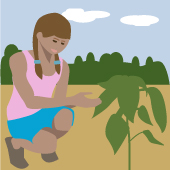Field Research
Licensed according to this deed.
Category
Published on
Abstract

Field Research
Some science is best carried out in nature. Studies where you need to identify all the different plant species in a habitat, count the number of pollinators that come and go from a certain kind of plant, or track changes in the color of autumn leaves might require outdoor trips to an interesting site. Some studies might involve data collection in your own back yard, school garden, or neighborhood park. Other studies may involve a single trip to collect seed or plant samples for more careful work in the lab.
Additional Web Resources for Field Work:
- Biodiversity in Your Backyard, by the Nuffield Foundation. This lesson plan describes a field experiment to measure species diversity on school grounds. It could be easily modified for use in a nearby park. A plant identification key is provided, but it primarily covers common UK species. http://www.nuffieldfoundation.org/practical-biology/biodiversity-your-backyard
- Discover Life, by The Polistes Foundation. Here you can search for specific species, identify sites where a species has been found, and learn to identify an organism from photos based on its location and traits. Some educational resources are also available. http://www.discoverlife.org/
- Encyclopedia of Life. This resource, which was first thought up by the well-known biologist E.O. Wilson, is a searchable knowledge base that aims to include all species living on Earth. Search for a species by its scientific or common name and find photos, a scientific description, and its conservation status. http://www.eol.org/
- Project BudburstSM: Timing is Everything! by the National Ecological Observatory Network, Inc., and the Chicago Botanic Garden. Here you can learn about phenology, the study of the timing of natural events. Project Budburst is an ongoing project, so you can map your own field observations here and find out what other "citizen scientists" have seen. http://budburst.org/
- Tree of Life, by the Tree of Life Project. This is a good resource for identifying relationships among different species based on current science on evolution. This site also includes photos and descriptions of biological families and genera. http://tolweb.org/tree/phylogeny.html
- The C.V. Starr Virtual Herbarium, by the New York Botanical Garden. This site shows plant samples from the NYBG's William and Lynda Steere Herbarium; it currently has about 225,000 images from over 1.3 million specimens. A glossary of botanical terms is included. http://sciweb.nybg.org/science2/VirtualHerbarium.asp
- Field Techniques Used by Missouri Botanical Garden, by R. Liesner. This page lists a set of articles describing the methods professional field botanists use to find and collect plant specimens, then prepare them for storage in an herbarium. http://www.mobot.org/MOBOT/Research/Library/liesner/tpage.htm
- Backyard Tree Identification Guide contains the basics of classifying & IDing different trees with some helpful pictures. https://www.homeadvisor.com/r/backyard-tree-identification-guide/
- iNaturalist is a great app to help identify local flora and fauna simply by sharing images, and fellow naturalists will help confirm or adjust your identifications. https://www.inaturalist.org/
- The LeafSnap plant identification app is an excellent resource to help identify plants. https://plantidentifier.info/
Cite this work
Researchers should cite this work as follows: